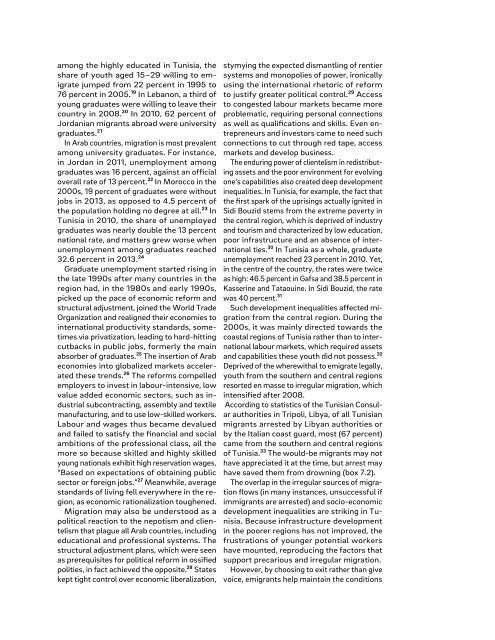Arab Human Development Report 2016
z6bSXU
z6bSXU
You also want an ePaper? Increase the reach of your titles
YUMPU automatically turns print PDFs into web optimized ePapers that Google loves.
among the highly educated in Tunisia, the<br />
share of youth aged 15–29 willing to emigrate<br />
jumped from 22 percent in 1995 to<br />
76 percent in 2005. 19 In Lebanon, a third of<br />
young graduates were willing to leave their<br />
country in 2008. 20 In 2010, 62 percent of<br />
Jordanian migrants abroad were university<br />
graduates. 21<br />
In <strong>Arab</strong> countries, migration is most prevalent<br />
among university graduates. For instance,<br />
in Jordan in 2011, unemployment among<br />
graduates was 16 percent, against an official<br />
overall rate of 13 percent. 22 In Morocco in the<br />
2000s, 19 percent of graduates were without<br />
jobs in 2013, as opposed to 4.5 percent of<br />
the population holding no degree at all. 23 In<br />
Tunisia in 2010, the share of unemployed<br />
graduates was nearly double the 13 percent<br />
national rate, and matters grew worse when<br />
unemployment among graduates reached<br />
32.6 percent in 2013. 24<br />
Graduate unemployment started rising in<br />
the late 1990s after many countries in the<br />
region had, in the 1980s and early 1990s,<br />
picked up the pace of economic reform and<br />
structural adjustment, joined the World Trade<br />
Organization and realigned their economies to<br />
international productivity standards, sometimes<br />
via privatization, leading to hard-hitting<br />
cutbacks in public jobs, formerly the main<br />
absorber of graduates. 25 The insertion of <strong>Arab</strong><br />
economies into globalized markets accelerated<br />
these trends. 26 The reforms compelled<br />
employers to invest in labour-intensive, low<br />
value added economic sectors, such as industrial<br />
subcontracting, assembly and textile<br />
manufacturing, and to use low-skilled workers.<br />
Labour and wages thus became devalued<br />
and failed to satisfy the financial and social<br />
ambitions of the professional class, all the<br />
more so because skilled and highly skilled<br />
young nationals exhibit high reservation wages,<br />
“Based on expectations of obtaining public<br />
sector or foreign jobs.” 27 Meanwhile, average<br />
standards of living fell everywhere in the region,<br />
as economic rationalization toughened.<br />
Migration may also be understood as a<br />
political reaction to the nepotism and clientelism<br />
that plague all <strong>Arab</strong> countries, including<br />
educational and professional systems. The<br />
structural adjustment plans, which were seen<br />
as prerequisites for political reform in ossified<br />
polities, in fact achieved the opposite. 28 States<br />
kept tight control over economic liberalization,<br />
stymying the expected dismantling of rentier<br />
systems and monopolies of power, ironically<br />
using the international rhetoric of reform<br />
to justify greater political control. 29 Access<br />
to congested labour markets became more<br />
problematic, requiring personal connections<br />
as well as qualifications and skills. Even entrepreneurs<br />
and investors came to need such<br />
connections to cut through red tape, access<br />
markets and develop business.<br />
The enduring power of clientelism in redistributing<br />
assets and the poor environment for evolving<br />
one’s capabilities also created deep development<br />
inequalities. In Tunisia, for example, the fact that<br />
the first spark of the uprisings actually ignited in<br />
Sidi Bouzid stems from the extreme poverty in<br />
the central region, which is deprived of industry<br />
and tourism and characterized by low education,<br />
poor infrastructure and an absence of international<br />
ties. 30 In Tunisia as a whole, graduate<br />
unemployment reached 23 percent in 2010. Yet,<br />
in the centre of the country, the rates were twice<br />
as high: 46.5 percent in Gafsa and 38.5 percent in<br />
Kasserine and Tataouine. In Sidi Bouzid, the rate<br />
was 40 percent. 31<br />
Such development inequalities affected migration<br />
from the central region. During the<br />
2000s, it was mainly directed towards the<br />
coastal regions of Tunisia rather than to international<br />
labour markets, which required assets<br />
and capabilities these youth did not possess. 32<br />
Deprived of the wherewithal to emigrate legally,<br />
youth from the southern and central regions<br />
resorted en masse to irregular migration, which<br />
intensified after 2008.<br />
According to statistics of the Tunisian Consular<br />
authorities in Tripoli, Libya, of all Tunisian<br />
migrants arrested by Libyan authorities or<br />
by the Italian coast guard, most (67 percent)<br />
came from the southern and central regions<br />
of Tunisia. 33 The would-be migrants may not<br />
have appreciated it at the time, but arrest may<br />
have saved them from drowning (box 7.2).<br />
The overlap in the irregular sources of migration<br />
flows (in many instances, unsuccessful if<br />
immigrants are arrested) and socio-economic<br />
development inequalities are striking in Tunisia.<br />
Because infrastructure development<br />
in the poorer regions has not improved, the<br />
frustrations of younger potential workers<br />
have mounted, reproducing the factors that<br />
support precarious and irregular migration.<br />
However, by choosing to exit rather than give<br />
voice, emigrants help maintain the conditions


